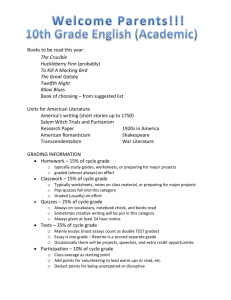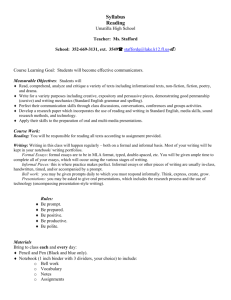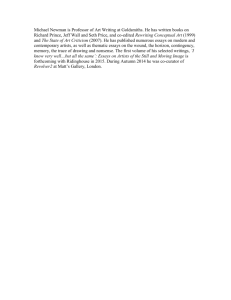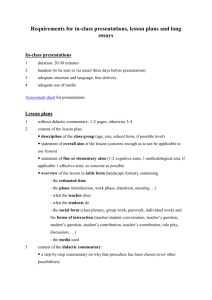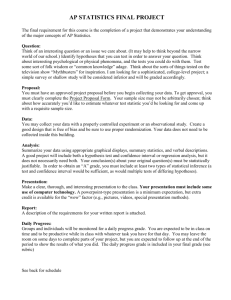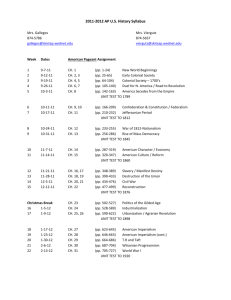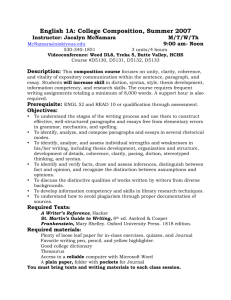BIOL142 - Laboratory for Introductory Biology
advertisement
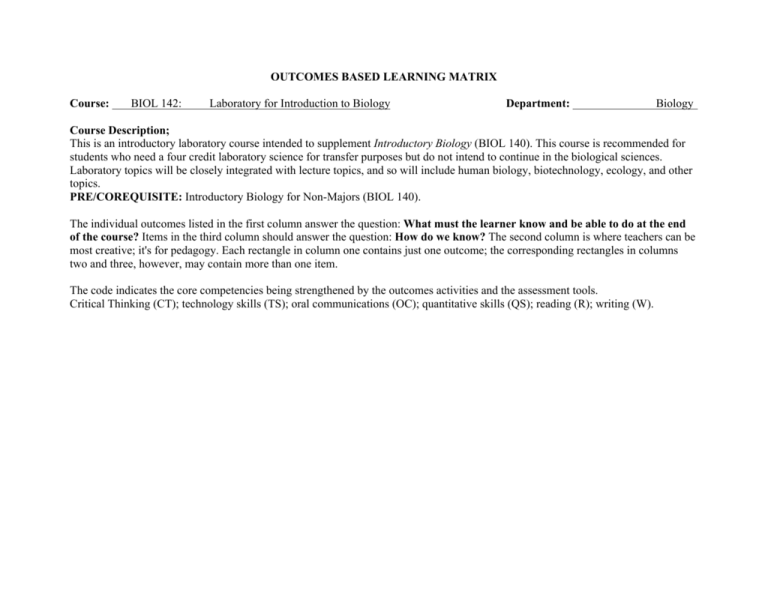
OUTCOMES BASED LEARNING MATRIX Course: BIOL 142: Laboratory for Introduction to Biology Department: Biology Course Description; This is an introductory laboratory course intended to supplement Introductory Biology (BIOL 140). This course is recommended for students who need a four credit laboratory science for transfer purposes but do not intend to continue in the biological sciences. Laboratory topics will be closely integrated with lecture topics, and so will include human biology, biotechnology, ecology, and other topics. PRE/COREQUISITE: Introductory Biology for Non-Majors (BIOL 140). The individual outcomes listed in the first column answer the question: What must the learner know and be able to do at the end of the course? Items in the third column should answer the question: How do we know? The second column is where teachers can be most creative; it's for pedagogy. Each rectangle in column one contains just one outcome; the corresponding rectangles in columns two and three, however, may contain more than one item. The code indicates the core competencies being strengthened by the outcomes activities and the assessment tools. Critical Thinking (CT); technology skills (TS); oral communications (OC); quantitative skills (QS); reading (R); writing (W). COURSE OUTCOMES Experience the scientific method by •! Asking scientific questions, •! Constructing testable hypotheses, •! Testing hypotheses experimentally, •! Analyzing presenting data, and •! Drawing conclusions or defending explanations on the basis of scientific evidence, in order to become scientifically literate and understand how scientists pursue answers to scientific questions. OUTCOMES ACTIVITIES •! Conduct experiments in lab, developing hypotheses, collecting data, interpreting data, drawing conclusions. (CT,R,W,TS,QS) •! Conduct experiments stressing importance of controls. (CT, R, W, TS, QS) •! Read and evaluate articles in the scientific literature, the popular literature and on the internet. (R, W, CT) Experience first-hand, through the observation and manipulation of the materials of science, the process of collecting and analyzing authentic and unpredictable scientific data in order to understand the process of science. •! •! •! •! •! Quizzes (CT, R, W) Lab worksheets (CT, R, W, QS) Lab reports (CT, R, W, QS) Short essays or papers (CT, R, W, TS) Oral Presentations (R, W, CT, TS, OC) •! Conduct experiments in lab, developing hypotheses, collecting data, interpreting data, drawing conclusions. (CT,R,W,TS,QS) •! Conduct experiments stressing importance of controls. (CT, R, W, TS, QS) •! Oral presentations/discussions using models, figures, or other materials (R, OC) •! •! •! •! •! Quizzes (CT, R, W) Lab worksheets (CT, R, W, QS) Lab reports (CT, R, W, QS) Short essays or papers (CT, R, W, TS) Oral Presentations (R, W, CT, TS, OC) Describe the role of a control group, the •! Conduct experiments stressing importance independent variable, and dependent of controls. (CT, R, W, TS, QS) variables in order to understand the process •! Lab activities and reports (R, W, TS, QS) of science and experimental design. •! Write short essays or reports (R, W) •! Oral presentations/discussions using models, figures, or other materials (R, OC) •! •! •! •! •! Quizzes (CT, R, W) Lab worksheets (CT, R, W, QS) Lab reports (CT, R, W, QS) Short essays or papers (CT, R, W, TS) Oral Presentations (R, W, CT, TS, OC) Perform simple mathematical calculations including conversions within the metric system, simple algebra, and basic statistics in order to analyze data. OUTCOMES ACTIVITIES •! Lab activities and reports (R, W, TS, QS) •! Write short essays or reports (R, W) •! Oral presentations/discussions using models, figures, or other materials (R, OC) Construct and interpret tables and graphs, both by hand and/or using Excel, in order to record and communicate the results of experiments. •! •! •! Use the vocabulary associated with the study of biology correctly in order to be able to read and understand the literature and laboratory instructions, and communicate effectively in a professional setting. Work safely in the laboratory and follow simple laboratory protocols in order to work cooperatively to complete laboratory exercises and conduct experiments using the scientific method. •! •! COURSE OUTCOMES •! •! •! •! •! Lab activities and reports (R, W, TS, QS) •! Write short essays or reports (R, W) •! Oral presentations/discussions using models, •! figures, or other materials (R, OC) •! •! Write short essays or reports (R, W) •! Oral presentations/discussions using models, •! figures, or other materials (R, OC) •! •! •! ASSESSMENT TOOLS Quizzes (CT, R, W) Lab worksheets (CT, R, W, QS) Lab reports (CT, R, W, QS) Short essays or papers (CT, R, W, TS) Oral Presentations (R, W, CT, TS, OC) Quizzes (CT, R, W) Lab worksheets (CT, R, W, QS) Lab reports (CT, R, W, QS) Short essays or papers (CT, R, W, TS) Oral Presentations (R, W, CT, TS, OC) Quizzes (CT, R, W) Lab worksheets (CT, R, W, QS) Lab reports (CT, R, W, QS) Short essays or papers (CT, R, W, TS) Oral Presentations (R, W, CT, TS, OC) •! Read and sign the safety sheet (CT, R) •! Observe student working safely in the lab (CT) •! Follow directions carefully in the lab (CT,R) •! Follow proper procedures for disposal of waste products (CT, R) COURSE OUTCOMES Use various tools or probes such as a microscope, an electronic scale, metric ruler, pipettes, micropipettes, and the Vernier system in order to collect data and develop good observational skills. Strengthen his or her Core Competencies in order to increase success in this and other courses and in the workplace. OUTCOMES ACTIVITIES •! Conduct experiments in lab, developing hypotheses, collecting data, interpreting data, drawing conclusions. (CT,R,W,TS,QS) •! Use the microscope use for an independent project and/or in several laboratory exercises (CT, R, TS, QS) •! Use the Vernier system to measure dissolved oxygen, pH, temperature, and other physical parameters in an aquatic ecosystem (CT, R, TS, QS) •! Use the Vernier system to measure CO2 production or O2 consumption (CT, R, TS, QS) •! Use quadrat and transect analysis to estimate plant biodiversity (CT, R, W, TS, QS) •! Assess the biodiversity of the Commonwealth and create a plan to further the preservation of biodiversity (CT, R, W, TS, QS, OC) •! Perform electrophoresis to generate a DNA profile (CT, R, TS, QS) •! Use dichotomous keys to identify unknown organisms (CT, R) Referenced above •! •! •! •! •! •! ASSESSMENT TOOLS Lab worksheets (CT, R, W, QS) Lab reports (CT, R, W, QS) Observe student using the microscope correctly in the lab (CT) Lab assignments requiring each student to focus and use the microscope (CT, OC, W, R) Observe student correctly conducting biodiversity analysis in the field (R, CT) Biodiversity assessment plan and presentation (CT, R, W, TS, QS) Referenced above.
